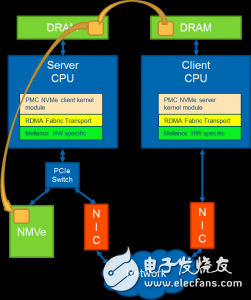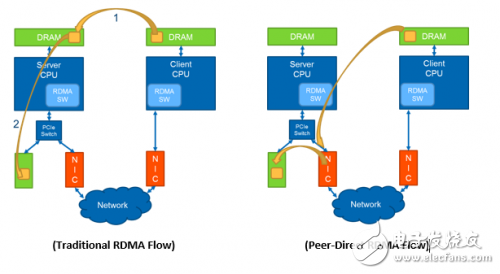Accelerating data transfer and pushing CPU and DDR bus efficiency to the extreme is a good data center architecture evaluation standard. Recently, PMC combined its NVRAM technology with high-speed network card company Mellanox to demonstrate the high-speed transmission examples of NVMe over RDMA and P2P, effectively freeing CPU and DDR bus resources, and significantly improving data transmission speed. The joint demonstration consists of two parts, first showing how NVMe and RDMA can be combined to provide low-latency, high-performance, block-based NVM access on a large scale at the remote end. The second part of the demo integrates Mellanox's RDMA peer-initiated operation with PMC's Flashtec NVRAM accelerator card, using memory-mapped I/O (MMIO) as an RDMA target for remote, massively persistent memory. access. The following will be introduced in detail one by one:
NVM Express over RDMANVMe over RDMA (NoR) demonstrates the potential for extending the NVMe protocol beyond RDMA. A total of two computers were used in the demonstration, one as a client and the other as a server with a Mellanox ConnectX-3 Pro NIC connected via RoCEv2. The NVMe device used in the demonstration is a very high performance and very low latency PMC Flashtec NVRAM accelerator card. The figure below is a block diagram of the demonstration.

This demonstration shows that using RDMA to transfer NVMe commands and data results in minimal additional latency without affecting throughput.
Comparing the average latency of the local NVMe device with the remote NVMe device, as shown in the following table, the delay increase in the NoR scheme is less than 10 microseconds.

The other set of data compares the test results of the local NVMe device and the remote NVMe device throughput. As can be seen from the table below, there is no reduction in throughput in the NoR scheme.

In this demonstration, the remote client is directly connected to a server's NVRAM/NVMe device by adding the server CPU and DRAM offload on top of the standard RDMA. We combined the RoCEv2-capable ConnectX-3 Pro RDMA NIC from Mellanox with PMC's Flashtec NVRAM accelerator card to enable peer-to-peer operation between the NIC and NVRAM. The peer initiated operation can achieve direct access to the NVRAM accelerator card by the remote client. Compared with the traditional RDMA process, the delay can be reduced and the CPU and DRAM resources can be effectively released.

Again, the two computers used in the demo, one as a client and the other as a server. The performance of the peer-initiated operation can be greatly improved by using the PCIe switching device in the server.
Comparing the background DRAM bandwidth available on the server with traditional RDMA and peer-initiated RDMA, the data obtained by perftest is as follows:

The following table compares the average latency when using traditional RDMA and peer-initiated RDMA. The result is derived from RDMA mode of fio:

Both RDMA and NVMe technologies are in a booming phase. RDMA provides long-distance, large-scale low-latency and high-efficiency data movement, while NVMe provides low-latency access to SSDs. Combine the two technologies to achieve extraordinary performance.
A high-speed slip ring is an electromechanical device that allows electrical current to pass between a stationary and a rotating assembly. It is typically used in applications where the speed requirement exceeds that which is achievable with a standard slip ring. High-speed slip rings are available in a variety of sizes and configurations to meet the needs of most applications. They are commonly used in military, aerospace, and medical applications where speed and reliability are critical.
The speed is required to be at least tens of thousands of revolutions per minute, the structure of the Conductive Slip Ring directly determines the contact of high speed, as well as the size of impedance. High-speed slip ring materials have high wear resistance, high life characteristics, and multi-contact contact can ensure signal transmission and power reliability, with the development of science and technology, high-speed slip rings will be more and more widely used.
If you need to transfer large amounts of data or power between two stationary objects, a high-speed conductive slip ring is what you need. Traditional slip rings only offer a few thousand revolutions per minute (RPM), which is more than enough for most applications, but can be limiting in some circumstances. Some applications, like those found in the medical or military field, require speeds of tens of thousands of RPM in order to function properly. That's where our high-speed conductive slip ring comes in. With speeds up to a certain range, it can handle even the most demanding applications.
High Speed Slip Ring,Rotary Slip Ring Electrical,Slip Electrical Connector,Hydraulic Rotary Joint
Dongguan Oubaibo Technology Co., Ltd. , https://www.sliprobs.com